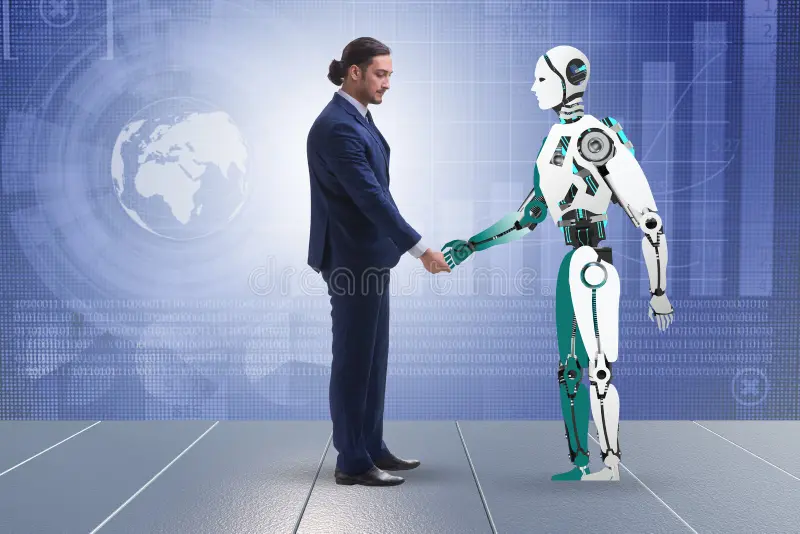Human-Machine Cooperation:

Releasing the Force of Cooperative energy
In the domain of business, where innovation and development consistently reshape the scene, one idea has arisen as a vital power: Human-machine cooperation. The combination of human insight and machine effectiveness has changed how organizations work, moving the concentration from manual assignments to key reasoning and critical thinking. This coordinated effort isn’t simply a pattern; It is a fundamental shift that is reshaping job roles, boosting productivity, and driving levels of operational excellence that have never been seen before.
**1. Rethinking Jobs, Releasing Potential**
At the core of human-machine coordinated effort is rethinking position jobs. With normal and tedious errands shared with machines through Mechanical Interaction Mechanization (RPA), representatives are freed from the repetitiveness of information passage, computations, and data recovery. This liberation does not aim to eliminate particular roles; rather, it’s tied in with releasing human potential to zero in on higher-request works that require imagination, the capacity to appreciate people at their core, and decisive reasoning.
**2. From Assignment Execution to Key Thinking**
Envision an existence where workers are not generally impeded by regulatory errands. All things being equal, they channel their endeavors into deciphering information bits of knowledge, concocting inventive methodologies, and going with informed choices. Businesses enable their employees to act as strategic advisors by automating routine tasks, leveraging their domain expertise to drive growth and competitive advantage. The real power of human-machine collaboration lies in the transition from task execution to strategic thinking.
**3. Exploring Complex Situations**
While machines succeed in executing tedious assignments with precision, they frequently battle when gone up against with intricacy, uncertainty, and nuanced navigation. Human ingenuity shines brightest in this area. Human workers are capable of navigating complicated situations, interpreting emotions, and comprehending context. Humans can guide automation processes through complex scenarios by collaborating with machines and making nuanced decisions that machines cannot duplicate.
**4. Developing a Learning Loop**
Human-machine joint effort doesn’t stop at robotization; it stretches out to constant improvement. As machines execute undertakings and cooperate with information, they produce important experiences. Human representatives can use these bits of knowledge to refine processes, recognize patterns, and make vital changes. This criticism circle guarantees that computerization turns into a dynamic, developing power that adjusts to changing business needs and economic situations.
**5. Upskilling and Continuous Education**
As job roles change, continuing education and upskilling become even more important. Representatives participate in preparing to get new abilities that supplement the capacities of robotization. This could include getting capability in information examination, man-made intelligence joining, or cycle advancement. Upskilling not just engages workers to team up really with machines yet in addition future-confirmations their vocation ways.
**6. Enhancing Customer Experiences**
The collaboration between humans and machines has a significant impact on customer experiences. Rapid responses, precise data processing, and streamlined procedures are all made possible by automation. In the mean time, human cooperation’s give the close to home association, compassion, and personalization that clients desire. By coordinating the qualities of the two people and machines, organizations can offer remarkable client encounters that figure out some kind of harmony among productivity and sympathy.
**7. Exploring Moral Considerations**
As people delegate undertakings to machines, moral contemplations come to the very front. Questions emerge about straightforwardness, responsibility, and predisposition in dynamic calculations. Ethical frameworks that dictate how humans supervise and intervene when necessary are required for the collaboration. To maintain trust and integrity, it is essential to strike a balance between the advantages of automation and ethical considerations.
**8. Driving Advancement and Creativity**
Human-machine joint effort isn’t just about making existing cycles more effective; it’s likewise an impetus for development and imagination. Employees have the mental capacity to participate in sessions of ideation, brainstorming, and problem-solving when routine tasks are automated. This cooperative climate turns into a favorable place for inventive thoughts that can change ventures and fuel business development.
Future Patterns in Mechanical Cycle Robotization (RPA)
The universe of innovation is set apart by steady development, and Mechanical Interaction Computerization (RPA) is no special case. RPA is poised to undergo transformative changes that will redefine how organizations operate, innovate, and adapt in a dynamic business landscape as businesses continue to embrace automation to streamline operations. In this segment, we investigate what’s in store drifts that are set to shape the direction of RPA.
**1. Mental Computerization: Past Repetition**
While conventional RPA centers around mechanizing rule-based, redundant assignments, the eventual fate of RPA lies in mental mechanization. Mental bots outfitted with computerized reasoning and AI capacities will have the capacity to fathom unstructured information, settle on nuanced choices, and handle undertakings that require human-like judgment and understanding. This development will empower RPA to wander past routine cycles and into domains that request mental ability.
**2. Hyper Automation: An End-to-End Approach**
Hype automation combines RPA with AI, machine learning, and process mining as complementary technologies. From data extraction and analysis to decision-making and action, this strategy aims to automate all processes. Hype automation use the qualities of different innovations to make an all encompassing computerization environment that smoothest out tasks as well as improves dexterity and responsiveness.
**3. Process Revelation and Computerization: Simulated intelligence Controlled Insights**
Process disclosure use man-made intelligence calculations to recognize processes that are ideal contender for computerization. Artificial intelligence (AI) identifies bottlenecks, inefficiencies, and areas with high automation potential by analyzing user behavior and system interactions. This trend enables businesses to strategically target automation efforts, ensuring that RPA is implemented where it has the greatest impact and value.
**4. Involved in Automation: Joint effort at the Desktop**
Gone to robotization centers around increasing human assignments by coordinating RPA straightforwardly into worker work processes. On the desktops of employees, bots assist with tasks, offer suggestions, and instantly automate routine actions. As a result of this seamless collaboration between humans and bots, productivity is increased, errors are reduced, and automation is tailored to individual work styles.
**5. Process Mining and Investigation: Experiences for Optimization**
RPA produces an abundance of information about cycles, connections, and execution. Analytics and process mining use this data to find actionable insights that can be used to improve automated processes, track key performance indicators, and find inefficiencies. These bits of knowledge drive constant improvement, permitting associations to refine their computerization procedures in light of genuine information.
**6. Community Builders: Democratizing Automation**
The role of citizen developers is becoming more prominent as RPA becomes more accessible. These are employees who don’t know much about technology and can use user-friendly RPA platforms to design, create, and implement automation solutions. The democratization of mechanization engages representatives across divisions to add to handle enhancement, driving development from the beginning.
**7. Up-skilling and Retraining: Human-Driven Evolution**
The ascent of mechanization prompts a reconsideration of labor force abilities. In order to provide employees with the expertise necessary to collaborate effectively with automation technologies, businesses will make investments in reskilling and upskilling programs. In order to create a human-machine partnership that maximizes operational efficiency, upskilled employees will play a crucial role in orchestrating and managing automation processes.
**8. Crossover Labor force: Obscuring Boundaries**
The qualification between human representatives and computerized laborers will obscure as associations embrace a mixture labor force model. Bots will consistently team up with people across different undertakings and capabilities, encouraging a harmonious relationship that use the qualities of every substance. The workforce is ensured to be adaptable, agile, and well-equipped for the digital age’s challenges by using this hybrid strategy.



